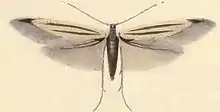Coleophora chalcogrammella
Coleophora chalcogrammella is a moth of the family Coleophoridae. It was first described by Philipp Christoph Zeller in 1839 and is found in Europe.
| Coleophora chalcogrammella | |
|---|---|
 | |
| Scientific classification | |
| Domain: | Eukaryota |
| Kingdom: | Animalia |
| Phylum: | Arthropoda |
| Class: | Insecta |
| Order: | Lepidoptera |
| Family: | Coleophoridae |
| Genus: | Coleophora |
| Species: | C. chalcogrammella |
| Binomial name | |
| Coleophora chalcogrammella | |
Description
The wingspan is 8–10 millimetres (0.31–0.39 in)
The larvae feed on thyme-leaf sandwort (Arenaria serpyllifolia), field mouse-ear, (Cerastium arvense), three-nerved sandwort (Moehringia trinervia), lesser stitchwort (Stellaria graminea) and greater stitchwort (Stellaria holostea). In autumn, the larvae make a short corridor, which widens into a small blotch, out of which the first case is cut. After hibernation, the final case is made. It is a brown, three-valved, tubular silken case of about 6 millimetres (0.24 in) long. The mouth angle is about 30°.[2] Full-grown cases can be found in May.
Pupa: The pupae of moths have visible head appendages, wings and legs which lie in sheaths.[3]
Distribution
It is found from Sweden and northern Russia to the Pyrenees and the Alps and from Great Britain to Romania.
References
- "Coleophora chalcogrammella Zeller, 1839". Fauna Europaea. Retrieved 11 December 2019.
- "Coleophora chalcogrammella". Plant Parasites of Europe. Retrieved 10 August 2020.
- "Coleophora chalcogrammella Zeller, 1839". UKflymines. Retrieved 11 December 2019.
External links

